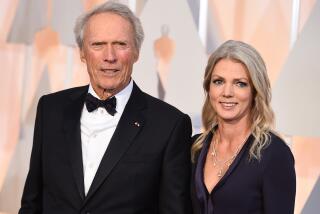FOLK BALLET OF MOISEYEV: ‘PEOPLE’S ART’
“I think you agree with me, it’s better to be met with flowers than with bombs.”
Igor Moiseyev, the 81-year-old director of the Moscow-based Moiseyev Dance Company, was not speaking abstractly.
His 155-member ensemble, back in the United States after a 12-year absence, was greeted earlier this month at the Metropolitan Opera House in New York by noxious tear gas--set off in the balcony only minutes into the folk troupe’s first performance on its 16-city U.S. tour.
The Met was promptly evacuated and the performance canceled. Yet if the intent of the action--first claimed in the name of, and then denied by, the Jewish Defense League--was to scare off audiences, the opposite occurred. The rest of the two-week New York run sold out quickly and extra performances were added for a later date.
In Los Angeles, the Moiseyev dancers are due for a two-week engagement at the Pantages Theater beginning Tuesday, Oct. 7, and extra security measures will be effected, according to the Nederlander Organization, the local co-sponsors.
“It doesn’t make it easy for us,” Moiseyev remarked dryly. But the tear-gas incident, similar to one that drove the dancers off the stage during a 1970 Chicago visit, served as well as a powerful political commentary.
The Moiseyev was the first major performing arts attraction booked in the friendly wake of the Reagan-Gorbachev spring summit, and this teary attack, coming just three days after the arrest in Moscow of American journalist Nicholas Daniloff, seemed to threaten further the basic premise of U.S.-Soviet cultural exchange.
The Moiseyev company is especially vulnerable to such volatile political expression. Unlike the revered Kirov Ballet, which toured the U.S. last spring, or the mighty Bolshoi Ballet (due next summer), the Moiseyev Dance Company speaks not the international language of classical dance but the nationalist idiom of folk movement.
Led by a director feted at home with three Stalin Prizes and the titles of “People’s Artist of the U.S.S.R.” and “Hero of Socialist Labor,” the company is perceived here as decidedly “Russian” and, as established by that government in 1937, certainly Soviet in its mission.
Getting backstage at the Met to meet with the senior figure of contemporary Russian dance had its own protocol. The interview had to be approved in advance by the Soviet consulate, and the company’s American press associates were obliged to declare “no questions about politics.” Security agents patroled the stage door and dressing-room hallways.
Moiseyev spoke in Russian, although he is also fluent in French, having spent some of his childhood in Paris. His measured but direct statements were translated by a company aide. Her enthusiasm brightened his more matter-of-fact demeanor, although the director--dapperly dressed--preened amiably for the camera.
“There are a great number of other folk companies in the U.S.S.R., but we are the only one that represents all 15 republics,” Moiseyev explained. He began his troupe 50 years ago, to satisfy the static artistic direction at the Bolshoi, where he then danced and choreographed to some acclaim.
“The purpose of my company,” he stated at the time, “is to create classic national dances . . . to raise the skill of performance of folk dance to the highest artistic level and to improve ancient dances in such a way as to influence the creation of new dances.”
Even today, as Moiseyev’s own choreographic horizons have expanded to again include greater balletic emphasis, folk dance remains a prime source for his creation and the identifying signature for the company.
On the touring program there are dance excerpts from Moldavia, Georgia, the Ukraine, Russia proper, and from the nomadic Kalmuks. On previous programs--this is the company’s sixth U.S. visit since 1958--one could have seen the performers take on the Hungarian czardas, Sicilian tarantella, or Argentine gaucho dances.
“The best way to preserve a language is to speak it,” Moiseyev insisted during the recent interview. “If you try to preserve a flower or herb, you can’t. When it dries, it’s no longer fresh.” The choreographer borrows freely from folk forms but rejects any responsibility for cultural authenticity. “If you put dances into a museum,” he said, “it leads to their death.”
In a country of such cultural array as the Soviet Union--with more than 180 officially recognized national groups--folk culture takes on a political dimension. Traditional troupes are encouraged because they affirm the notion of the nation as a friendly association of diverse peoples. In other words, the Moiseyev provides domestic cultural exchange on its own turf.
But in practice both the Russian republic and the Russian language dominate the Soviet Union. This is true at the Moiseyev school as well, where most students--and therefore later members of the ensemble--come from the Moscow area. The company does not actively recruit from other regions.
Moiseyev denies the suggestion that such a policy could lead to nationalist resentment in the provinces. “It’s a matter of quality,” he said. “If you dance their folk dances better (than the local troupes), they applaud.”
“Those who don’t start in our schools have a lower professional level,” he stated unapologetically, “so a Russian girl in our school dances Moldavian dance much better than a Moldavian girl.”
Moiseyev seemed especially proud of his dancers’ versatility. “They can dance classical and folk dance and many of them are good acrobats,” he said. Ballet steps are quite apparent in many of the numbers, especially in “At the Skating Rink,” receiving its first U.S. performances on this tour. Often humorous, this divertissement may remind many of Frederick Ashton’s “Les Patineurs.”
More contemporary dance has its play in Moiseyev’s one-act “Night on Bald Mountain” (also being presented in this country for the first time), based on the Mussorgsky tone poem. The devils and witches in that work’s bacchanal revel in the jitterbug, shimmy, and even the bump-and-grind.
The Moiseyev choreography, whether traditional or original, is demanding athletically--for men and women--with multiple leaps, deep bends and almost frantic footwork. Yet performer injuries are less common than in the more exclusively oriented ballet companies, the director claimed, “because our dancers are better trained. They start at age 17, and after 20 years have the right to retire and go on pension.”
A remarkably fit octogenarian, Moiseyev himself is hardly the retiring type. Although he no longer teaches regular class, he demonstrates “with the body, hands and feet” when staging new dances. A strict regimen of exercise, diet and rehearsal keeps him trim. “If it would be necessary for me to go on stage, I could do it.”
But he says he doesn’t miss performing. “When I see the dancers on stage,” he mused, “it seems that I am doing the steps. The dancers express my thoughts, my feelings, my temperament--all the movements which I created myself. There’s no necessity for me to go on stage.”
Despite such ongoing identification with the work, Moiseyev has managed to maintain a personal distance from the political protest that occasionally greets his troupe when it travels abroad. “We are more disappointed than afraid,” he reported of the opening-night disturbance in New York. “But we don’t connect it in any way with the American audience. It was just an incident created by a separate chauvinist organization which has its own aim to break the cultural exchange.
“We don’t understand why somebody has a right to prevent people from seeing what they want to see.”
As a folk artist, Igor Moiseyev has always championed populist expression and cultural vitality. “Ours is a people’s art,” he has declared. “We live in the people’s tradition.”
More to Read
The biggest entertainment stories
Get our big stories about Hollywood, film, television, music, arts, culture and more right in your inbox as soon as they publish.
You may occasionally receive promotional content from the Los Angeles Times.






